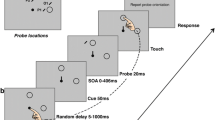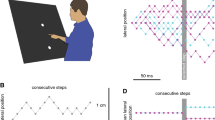Abstract
The accuracy of reaching movements to memorized visual target locations is presumed to be determined largely by central planning processes before movement onset. If so, then the initial kinematics of a pointing movement should predict its endpoint. Our study examined this hypothesis by testing the correlation between peak acceleration, peak velocity, and movement amplitude and the correspondence between the respective spatial positions of these kinematic landmarks. Subjects made planar horizontal reaching movements to targets located at five different distances and along five radially arrayed directions without visual feedback during the movements.The spatial dispersion of the positions of peak acceleration, peak velocity, and endpoint all tended to form ellipses oriented along the movement trajectory. However, whereas the peaks of acceleration and velocity scaled strongly with movement amplitude for all of the movements made at the five target distances in any one direction, the correlations with movement amplitude were more modest for trajectories aimed at each target separately. Furthermore, the spatial variability in direction and extent of the distribution of positions of peak acceleration and peak velocity did not scale differently with target distance, whereas they did for endpoint distributions. Therefore, certain features of the final kinematics are evident in the early kinematics of the movements as predicted by the hypothesis that they reflect planning processes. However, endpoint distributions were not completely predetermined by the Initial kinematics. In contrast, multivariate analysis suggests that adjustments to movement duration help compensate for the variability of the initial kinematics to achieve desired movement amplitude. These compensatory adjustments do not contradict the general conclusion that the systematic patterns in the spatial variability observed in this study reflect planning processes. On the contrary, and consistent with that conclusion, our results provide further evidence that direction and extent of reaching movements are planned and determined in parallel over time.
Similar content being viewed by others
Author information
Authors and Affiliations
Additional information
Received: 23 March 1998 / Accepted: 2 September 1998
Rights and permissions
About this article
Cite this article
Messier, J., Kalaska, J. Comparison of variability of initial kinematics and endpoints of reaching movements. Exp Brain Res 125, 139–152 (1999). https://doi.org/10.1007/s002210050669
Issue Date:
DOI: https://doi.org/10.1007/s002210050669




